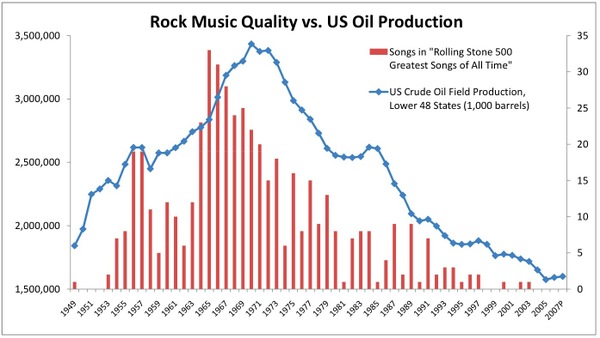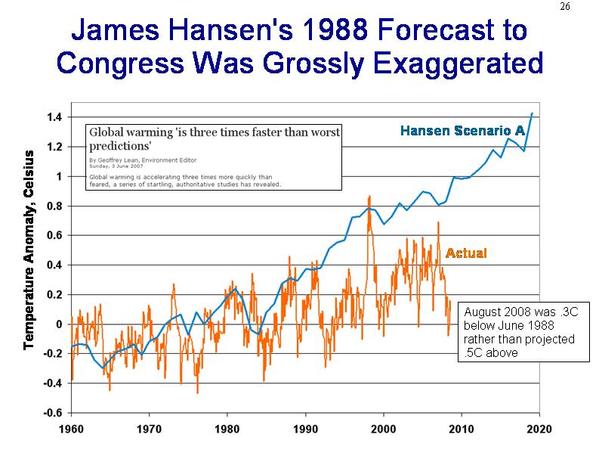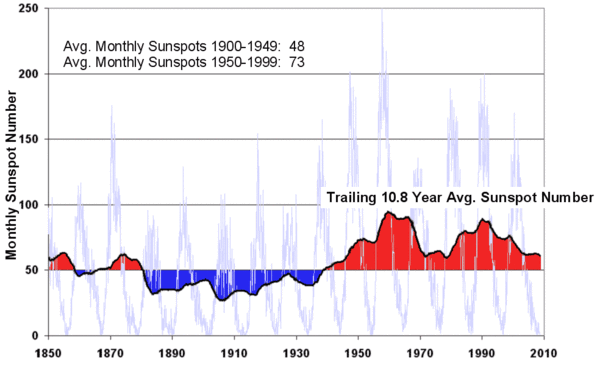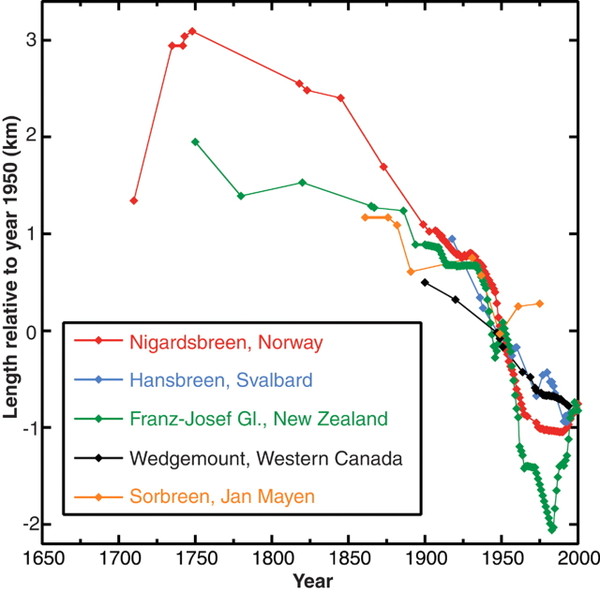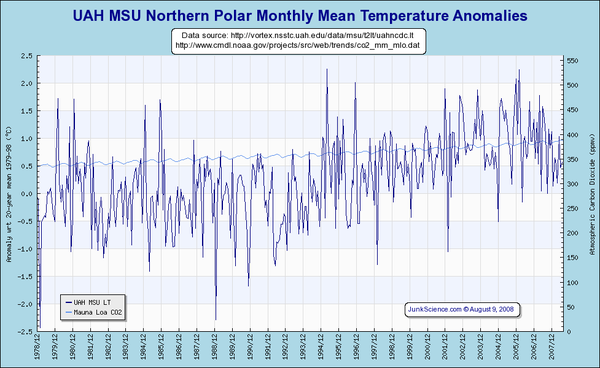Hat Tip to a reader. I am envisioning a "Team America: World Police" sequel.
Monthly Archives: September 2008
Make Sure “Climate Change” is in Your Grant Application
The best way to get grant money nowadays is to try to draw from a torrent of global warming money. I would say that the first rule of grant application writing today is "include climate change in your study."
Examples, sent by a reader:
From the Correlation Not Equal Causation Department
More here. Maybe we can get Mann to calculate some correlation statistics for this.
RCRC Climate Presentation
I made a 30-minute presentation to the California Regional Council of Rural Counties yesterday. The audience was mainly county supervisors and other officials from about 30 rural counties. The presentation was the skeptical counterpoint to a presentation by Joe Nation, who among other accomplishments was an author of AB32, the California global warming abatement law. Download RCRC_Global_Warming_Presentation_update_Sept-25-2008.ppt . Some of the charts may not be self-explanatory, so I am working on a YouTube video with my speech overlaid on the slides.
It was an interesting experience for me because the audience was hugely sympathetic to my pitch, but frustrated because, for them, it was beside the point: They were already committed by AB32 to take drastic and expensive action under AB32. The only policy recommendation I made in my speech was to lament the obsession with cap-and-trade and make a plea for a carbon tax. The discussion afterward pretty much made my point for me, with every member lamenting the absurdities that are emerging in the CARB regulation process. Even Mr. Nation admitted that the CARB is setting up programs that are preferentially regulating those with the least political muscle and pushing policies which make no sense in any kind of cost-benefit analysis for fighting CO2. Mr. Nation said that when he was in the legislature, he tried a carbon tax first but could not get it out of committee, even a small one that would have raised gas taxes about 5 cents. It seems politicians have no problem enacting huge taxes (which is what AB32 does) as long as those taxes are not called a tax and are hidden from the view of the general public (at least until prices start to rise and businesses start to exit the state).
I thought Mr. Nation did a perfectly reasonable job, and I agreed with much of what he presented. I differed only, of course, in the amount of past warming I was willing to ascribe to CO2 and the amount of future warming from CO2 that we might expect. However, this was the first time I have ever seen a global warming catastrophist be explicit that CO2 only causes a bit of future warming, and that most is from positive feedbacks multiplying the greenhouse effect. Kudos for him for highlighting this, and this certainly fed into my pitch well.
The one area where I thought he made an explicit factual mistake in his presentation was in evaluating Hansen’s forecast to Congress in 1988. He argued that one shouldn’t judge Hansen by his "A" scenario (which is WAY off) because Hansen said at the time that this was based on unrealistically high assumptions. But in Hansen’s appendix, he says that the A scenario is based on 1.5% a year future growth in CO2 output. In fact, the world has grown CO2 output by 1.75 % a year in the last 20 (source), so in fact the A scenario is, if anything, low. The B and C scenarios should be treated as totally irrelevant. This is a mistake I think Lucia made at the Blackboard, considering B and C at all. These scenarios differ in their CO2 forecasts, not the model parameters, so the scenario closest to actual CO2 output should be chosen and the rest are irrelevant. By the way, here is my chart. As I did with many of my charts, I like to counterpoint the data against media reports (the box in the upper left). This helps later in the discussion when the disconnect people have between what I have said and what they have heard inevitably crops up.
I was pleased that Russ Steele of NC Media Watch was there to say hi and observe the proceedings. Thanks Russ — I enjoy your blog and am sorry that I did not recognize you in my pre-presentation stress.
Update: Russ has a more complete roundup of the discussion
Update 2: The actuals in the chart above are UAH satellite numbers, with the anomaly shifted up about 0.1C to match zero values with the Hansen forecast data.
Computer Models
Al Gore has argued that computer models can be trusted to make long-term forecasts, because Wall Street has been using such models for years. From the New York Times:
In fact, most Wall Street computer models radically underestimated the risk of the complex mortgage securities, they said. That is partly because the level of financial distress is “the equivalent of the 100-year flood,” in the words of Leslie Rahl, the president of Capital Market Risk Advisors, a consulting firm.
But she and others say there is more to it: The people who ran the financial firms chose to program their risk-management systems with overly optimistic assumptions and to feed them oversimplified data. This kept them from sounding the alarm early enough.
Top bankers couldn’t simply ignore the computer models, because after the last round of big financial losses, regulators now require them to monitor their risk positions. Indeed, if the models say a firm’s risk has increased, the firm must either reduce its bets or set aside more capital as a cushion in case things go wrong.
In other words, the computer is supposed to monitor the temperature of the party and drain the punch bowl as things get hot. And just as drunken revelers may want to put the thermostat in the freezer, Wall Street executives had lots of incentives to make sure their risk systems didn’t see much risk.
“There was a willful designing of the systems to measure the risks in a certain way that would not necessarily pick up all the right risks,” said Gregg Berman, the co-head of the risk-management group at RiskMetrics, a software company spun out of JPMorgan. “They wanted to keep their capital base as stable as possible so that the limits they imposed on their trading desks and portfolio managers would be stable.”
Tweaking model assumptions to get the answer you want from them? Unheard of!
We Can’t Think of Anything Else It Could Be
I am still reading the new Douglas and Christy paper, so I won’t comment on it yet, but you can see Anthony Watts thoughts here.
However, in reading Anthony’s site this morning, I was struck by a quote in another one of his posts. For a while, I have been telling folks that the main argument behind anthropogenic global warming is "we have looked at everything else, and we can’t think of what else it could be other than man." Lacking positive correlation between CO2 and major shifts in temperature (particularly when ice core evidence collapsed under the weight of the 800 year lag), scientists instead argue that they have gone through a long checklist (sun, clouds, volcanoes, etc) and have convinced themselves none of these others have caused late 20th century warming, so it must be man — that’s all that is left.
Here is an example, from Anthony’s site:
Bill Chameides, dean of Duke University’s Nicholas School of the Environment and Earth Sciences, said Spencer’s arguments are what magicians call “ignoratio elenchi” or logical fallacy.”We’ve looked at every possible form of heat, including clouds, and the only source of heat is greenhouse gases,” he said, adding it’s insulting that Spencer would suggest scientists are paid to come to this conclusion. “Scientists make their reputation on debunking theories.”
Well, a number of folks would beg to differ that scientists have truly eliminated every other possible cause, particularly Mr. Sun (more than really eliminating these effects, they seem to be seeking excuses to ignore them). In fact, climate models of late have admitted that they don’t even include the Pacific Decadal Osculation in their models, or didn’t until recently. So much for thinking of everything.
But if Mr. Chameides wants to talk in terms of logical fallacies, I will as well: Just because scientists cannot image another cause does not mean that another cause does not exist. Can you imagine the first astrophysicists to discover pulsars to say "well, we can’t think of anything else that would cause this phenomenon, so it must be space aliens." Well, come to think of it, some people did say that. But it turned out to be absurd, and after some decades of effort, we think we now understand pulsars. But it is a bizarre form of arrogance to assume that it is not possible in our current degree of climate knowledge that there is some factor we don’t even know about.
Long Postscript: I am working on a powerpoint presentation for next week on anthropogenic global warming, but here are two charts from that presentation that get at the "we can’t think of anything other than man that might be causing late 20th century warming." The first is the correlation between 20th century temperature and the PDO cycle (temperature numbers are Hadley CRUT3 and UAH combined as described here). By the way, there seems to be some argument over exactly where and how often to call the turns in the PDO early in the 20th century — I have used one frequent estimate but others exist.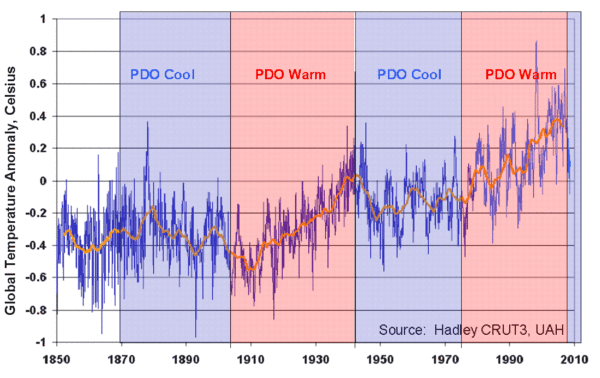
The second interesting analysis is a sunspot number chart. To highlight recent increases in activity, I have overlaid on the monthly International sunspot numbers (light blue) a 9.8 year moving average (in black) of sunspot numbers (9.8 selected as an average cycle length). In the chart below, selection of the 50 average sunspot number as a reference value is arbitrary, but serves to visually demonstrate the increase in solar activity over the last 50 years.
The average monthly sunspot number from 1900-1949 was 48. The average monthly number from 1950-1999 was 73.1, an increase of 52%.
Some of this increase is real, but some may be a measurement bias related to the ability to better detect smaller spots. Anyone have any sources on how large this latter effect might be? We are talking about an enormous percentage increase in the last half of the century, so my guess is that it is not all due to this bias.
Retreating Glaciers
One of the panicky claims of global warming catastrophists is that some sort of "unprecedented" melting and retreat of glaciers is occurring tied to anthropogenic global warming. I have seen anecdotal evidence for a while that this melting of glaciers began long before the 1950-present "anthropogenic" era, but I had not seen anything systematic on the topic until I discovered this study by L. Oerlemans et al as published in Science in 2005. Download Oerlemans 2005 as pdf. His results look like this (click to enlarge):
His data for the last decade is a little squirrelly because the data sets he uses are slow to update, but the overall picture is pretty clear — a pretty steady 150+ year history of steady retreat, with the only change is slope being a flattening rather than an acceleration of the curve. Here are a few individual glaciers he highlights:
One is again left in a quandary – if recent glacial retreats are due to anthropogenic warming, then what cased the retreats before 1950 or so? And, whatever caused the earlier retreats, what made this natural effect "switch off" at the exact same instant that anthropogenic effects took over?
Update: Here is a piece of annecdotal evidence to match, a map from Alaska Geogrpahic on the retreat of the glaciers at Glacier Bay

Retreating Glaciers
One of the panicky claims of global warming catastrophists is that some sort of "unprecedented" melting and retreat of glaciers is occurring tied to anthropogenic global warming. I have seen anecdotal evidence for a while that this melting of glaciers began long before the 1950-present "anthropogenic" era, but I had not seen anything systematic on the topic until I discovered this study by L. Oerlemans et al as published in Science in 2005. Download Oerlemans 2005 as pdf. His results look like this (click to enlarge):
His data for the last decade is a little squirrelly because the data sets he uses are slow to update, but the overall picture is pretty clear — a pretty steady 150+ year history of steady retreat, with the only change is slope being a flattening rather than an acceleration of the curve. Here are a few individual glaciers he highlights:
One is again left in a quandary – if recent glacial retreats are due to anthropogenic warming, then what cased the retreats before 1950 or so? And, whatever caused the earlier retreats, what made this natural effect "switch off" at the exact same instant that anthropogenic effects took over?
Update: Here is a piece of annecdotal evidence to match, a map from Alaska Geogrpahic on the retreat of the glaciers at Glacier Bay

Light Posting
Sorry for the light posting. I have not lost interest, I have just been extremely busy. Relevant to climate, I am working on a 30-minute presentation for a climate debate I am participating in soon at Lake Tahoe. Once that is done, the material I have developed for it should drive a number of new posts.
Comment Policy
Since it has come up a couple of times in the last few days, here is a reminder of the comment policy on this blog:
1) I do not edit, moderate or delete comments, except for outright spam. The reasons for this are many. First, I don’t have time. Second, I don’t have the inclination. Third, I take zero responsibility from an editorial standpoint on what is in the comments. The comments are an open public forum I offer as a public service. Even light moderation or isolated bans would break this bright-line rule and might lead some to some confusion as to whether I implicitly support some particular comment because I didn’t delete it. So I don’t touch anything.
2) I encourage everyone who agrees with me to remain civil, rational, open-minded, and professional in the comments. Everyone else is encouraged to discredit his or her own opinions by making as much of an ass of him or herself as they choose. Some of my commenters seem particularly adept at the latter.
3) Commenter names are entirely arbitrary. It is amazing that I have to remind folks of this nowadays, but if you see a commenter named "Al Gore," you should be entirely suspicious as to the person’s true identity (though of course Al would be welcome to hang out here). Its not like I check everyone’s ID.
Sucking the Oxygen Out of the Environmental Movement
I have written on a number of occasions that, years from now, folks who would like to see meaningful reductions in man’s negative impacts on the environment are going to look back on the global warming charade as a disaster for their movement — not just in terms of credibility, but in terms of lost focus on real, meaningful improvements.
China is a great example. Like London in the 19th century or Pittsburgh in the early 20th, China’s air quality is a mess. Real steps need to be taken to clean up the air, for the health and safety of its residents. The Olympics might have been a venue for people around the world to apply pressure to China to clean up its act.
But, in fact, there is little real pressure from outside for China to clean up the soot, unburned hydrocarbons, NO2, SO2 and other such pollutants from its vehicles and coal plants. That is because all the pressure, all the attention, is on China’s CO2 production. But there is nothing China can do to slow down CO2 growth without killing its economy and probably destabilizing its government in the process. So, it gives the world a big FU to such admonitions.
Which is a shame. Unlike for CO2 abatement, there are real technologies that are proven to be economic that can abate the worst of China’s pollution problems. Had we instead been spending our moral capital pressuring China to take such steps, there might be real progress.
This is all the more true as we learn that some of the problems we ascribe to CO2 may in fact be more linked to soot from Chinese industry. John Goetz recently linked one such story:
Smog, soot and other particles like the kind often seen hanging over Beijing add to global warming and may raise summer temperatures in the American heartland by three degrees in about 50 years, says a new federal science report released Thursday.
These overlooked, shorter-term pollutants — mostly from burning wood and kerosene and from driving trucks and cars — cause more localized warming than once thought, the authors of the report say.They contend there should be a greater effort to attack this type of pollution for faster results.For decades, scientists have concentrated on carbon dioxide, the most damaging greenhouse gas because it lingers in the atmosphere for decades. Past studies have barely paid attention to global warming pollution that stays in the air merely for days.
This is consistent with other recent work that hypothesizes that increase of melting rates of Arctic sea ice may be as much due to Chinese black carbon falling on the ice (and thereby decreasing its albedo and increasing solar heating) than from rising global temperatures. This makes sense to me, and may help explain why melting in the Arctic sea ice was nearly as great as last year’s record, despite much lower Arctic temperatures (see below) over the last year.
Lipstick on a Pig
Apparently, Michael Mann is yet again attempting a repackaging of his hockey stick work. The question is, has he re-worked his methodologies to overcome the many statistical issues third parties have had with his work, or is this more like AirTran changing its name from ValuJet to escape association in people’s mind with its 1996 plane crash?
Well, Steve McIntyre is on the case, and from first glance, the new Mann work seems to be the same old mish-mash of cherry-picked proxies, bizarre statistical methods, and manual tweaking of key proxies to make them look the way Mann wants them to look. One thing I had never done was look at all the component proxies of the temperature reconstructions all in one place. At the link above, Steve has all the longer ones in a animated GIF. It is really striking how a) almost none of them have a hockey stick shape and b) even the few that do have HS shapes typically show the warming trend beginning in 1800, not in the late 19th century CO2 period.
If you would like to eyeball all 1209 of the proxies Mann begins with (before he starts cherry picking), they are linked here. I really encourage you to click through to one of the five animations, just to get a feel for it. As someone who has done a lot of data analysis, it is just staggering that he can get a hockey stick out of these and claim that it is in some way statistically significant. It is roughly equivalent to watching every one of your baseball team’s games, seeing them lose each one, and then being told that they have the best record in the league. It makes no sense.
The cherry-picking is just staggering, though you have to read the McIntyre articles as a sort of 2-3 year serial to really get the feel of it. However, this post gives one a feel of how Mann puts a thin statistical-sounding veneer to cover his cherry-picking, but at the end of the day, he has basically invented a process that takes about a thousand proxy series and kicks out all but the 484 that will generate a hockey stick.
Update: William Briggs finds other problems with Mann’s new analysis:
The various black lines are the actual data! The red-line is a 10-year running mean smoother! I will call the black data the real data, and I will call the smoothed data the fictional data. Mann used a “low pass filter” different than the running mean to produce his fictional data, but a smoother is a smoother and what I’m about to say changes not one whit depending on what smoother you use.
Now I’m going to tell you the great truth of time series analysis. Ready? Unless the data is measured with error, you never, ever, for no reason, under no threat, SMOOTH the series! And if for some bizarre reason you do smooth it, you absolutely on pain of death do NOT use the smoothed series as input for other analyses! If the data is measured with error, you might attempt to model it (which means smooth it) in an attempt to estimate the measurement error, but even in these rare cases you have to have an outside (the learned word is “exogenous”) estimate of that error, that is, one not based on your current data.
If, in a moment of insanity, you do smooth time series data and you do use it as input to other analyses, you dramatically increase the probability of fooling yourself! This is because smoothing induces spurious signals—signals that look real to other analytical methods. No matter what you will be too certain of your final results! Mann et al. first dramatically smoothed their series, then analyzed them separately. Regardless of whether their thesis is true—whether there really is a dramatic increase in temperature lately—it is guaranteed that they are now too certain of their conclusion.
and further:
The corollary to this truth is the data in a time series analysis is the data. This tautology is there to make you think. The data is the data! The data is not some model of it. The real, actual data is the real, actual data. There is no secret, hidden “underlying process” that you can tease out with some statistical method, and which will show you the “genuine data”. We already know the data and there it is. We do not smooth it to tell us what it “really is” because we already know what it “really is.”
Update: I presume it is obvious, but the commenter "mcIntyre" has no relation that I know of to the "mcintyre" quoted and referred to in the post. As a reminder of my comment policy, 1) I don’t ban or delete anything other than outright spam and 2) I strongly encourage everyone who agrees with me to remain measured and civil in your tone — everyone else is welcome to make as big of an ass out of him or herself as they wish.
By the way, to the commenter named "mcintyre," I have never ever seen the other McIntyre (quoted in this post) argue that CO2 does not act as a greenhouse gas. He spends most of his time arguing that the statistical methods used in certain historic temperature reconstructions (e.g. Mann’s hockey stick but also 20th century instrument rollup’s like the GISS global temperature anamoly) are flawed. I have read his blog for 3 years now and can honestly say I don’t know what his position on the magnitude of future anthropogenic warming is. Mr. McIntyre is apparenlty not alone — Ian Jolliffe holds the opinion that the reputation of climate science is being hurt by the statistical sloppiness in certain corners of dendro-climatology.
Be Cool and Prevent Cooling by Reducing Global Warming
I seldom highlight stories like this, because I am more interested in the science than the propoganda of climate issues, but I just couldn’t resist this story. Via Tom Nelson, from Belleville News Democrat:
Speakers at the public forum also addressed how global warming may directly affect metro-east residents, citing this summer’s flooding and unusually cool weather, and future impact on agriculture.
"These are symptoms of global warming," said Kathy Andria, who represented the American Bottoms Conservancy at the forum.
Andria said she will help organize Belleville residents to work towards being a greener city and become designated by the Sierra Club as a Cool City.
So we want to fight global warming which is causing unusually cool weather. If we are succesful, then we will be labelled a Cool City so that we won’t have all this cool weather because we will have stopped warming.
Seriously, has there even been a more transparent "heads I win, tails you lose" argument than saying that unusually cool weather is evidence of global warming?




